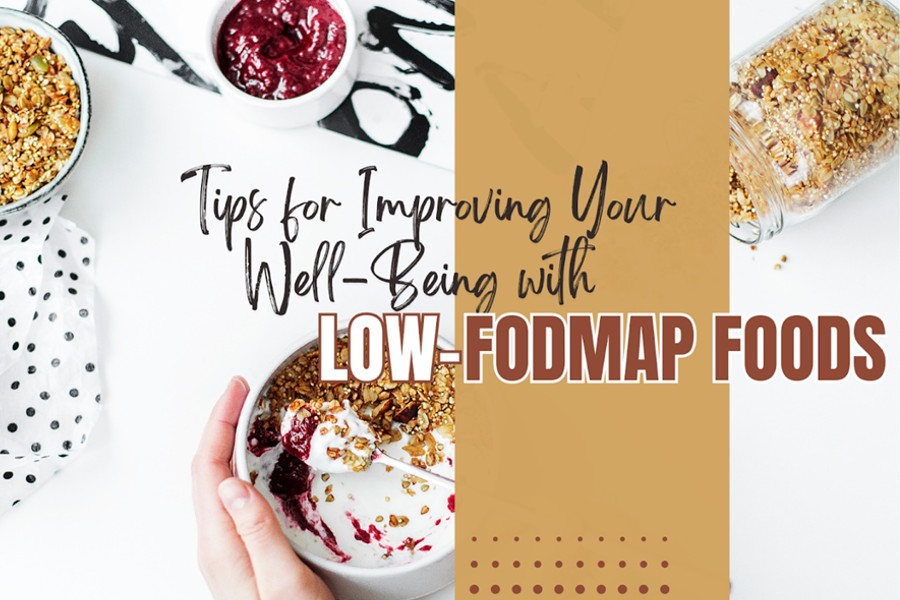
Are you struggling with digestive issues? Digestive issues can vary from mild discomfort to more severe conditions, significantly impacting daily life.
These issues can be caused by various factors, such as food intolerances, stress, or gastrointestinal disorders like irritable bowel syndrome (IBS).
A low-FODMAP diet is the key to unlocking better gut health and overall well-being. Studies show that up to 86% of IBS patients report improvements in gastrointestinal symptoms when following a low-FODMAP diet.
Let’s explore practical tips for navigating low FODMAP foods to enhance your digestive health.
1. With a food journal, identify your triggers.
The journey to better gut health starts with understanding your body’s signals. Keeping a detailed food journal is important, which will allow you to know what foods trigger symptoms. Tracking what you eat will help you create a personalized low-FODMAP plan that works best for you. This personalized fit is what makes all the difference, as everyone’s body reacts differently to various types of food.
Record your meals, symptoms, and portion sizes by using the Monash FODMAP app or an easy notebook. The key here is to be as consistent and detailed as possible.
2. Embrace Meal Planning and Batch cooking.
Success on a low FODMAP diet often comes down to preparation. By planning meals and cooking in batches, you can significantly reduce the stress of daily meal prep. This approach helps ensure you always have safe, low-FODMAP options readily available, minimizing the risk of turning to high-FODMAP convenience foods.
Moreover, batch cooking saves time and reduces the mental load during mealtime, allowing you to focus on your well-being instead of scrambling for something to eat. A low FODMAP Meal Delivery service provides an excellent alternative for those looking to streamline their low-FODMAP diet.
These services offer pre-made, FODMAP-friendly meals that are conveniently delivered to your door, taking the guesswork out of preparation and ensuring you stay on track with your dietary goals.
3. Embrace low-FODMAP Fruits and vegetables.
Contrary to common belief, you can eat fruits and vegetables on a low-FODMAP diet. There are numerous varieties of very tasty, nutritious options that are normally low-content FODMAP foods.

Common triggers should be avoided: Apples, pears, onions, and garlic have a high FODMAP count and are best kept to a minimum.
Remember, the low-FODMAP diet is considered the most evidence-based dietary intervention for IBS. By incorporating these fruits and vegetables, you’re not just managing symptoms instead, you’re nourishing your body with essential nutrients.
4. Master the Art of FODMAP-Friendly Substitutions
But don’t let your favorite recipes fall by the wayside either. Some nifty substitutions are there to ensure that you get to enjoy the most delicious meals without veering off your low FODMAP plan.
Here are some smart swaps:

These substitutions allow you to enjoy flavorful and varied meals without compromising your digestive comfort.
5. Practice Portion Control for Success
When it comes to FODMAPs, quantity is just as important as quality. Even low-FODMAP foods can be problematic because their portions are too large. FODMAPs may add up inside of your system, so keeping the portion sizes controlled helps ensure that you don’t exceed your limits of tolerance.
For example, eating a few raspberries may not cause issues, but a large bowl could trigger symptoms. Note that some low-FODMAP foods, when overconsumed in one sitting, can add up the FODMAP amount in a hurry.
6. Stay Hydrated with FODMAP-Friendly Beverages
Proper hydration is key to overall well-being, but some drinks can be sneaky sources of FODMAPs. Choose your beverages wisely to support your digestive health.
On a low-FODMAP diet, water is always a safe choice, providing hydration without digestive concerns. Herbal teas, such as peppermint and ginger, are excellent choices as they can soothe the digestive system and provide additional benefits. Small amounts of lactose-free milk can be included if tolerated.
However, It’s best to avoid chamomile tea, some coffees, and drinks with high fructose corn syrup, as these can exacerbate digestive issues. By making these informed choices, you can better manage your symptoms and support overall digestive health.
7. Navigate Hidden FODMAPs in Processed Foods
Processed foods are frequently made with stealthy FODMAP ingredients that will sabotage your efforts. Learning to read labels and identify hidden FODMAPs is crucial for success on a low-FODMAP diet.
Common hidden FODMAPs:
- High fructose corn syrup
- Inulin or chicory root
- Artificial sweeteners like sorbitol or mannitol
Always read ingredient lists carefully, and when in doubt, choose whole, unprocessed foods.
- Lincoln Theodore Monroe Andrew Perry, “Stepin Fetchit,” The Rise And Fall Of The First Black Super Star, 1902 – 1985
- Sponsored Love: AARP Plan F Benefits, What You Need To Know?
- Discover 5 Reasons Of Class Events Is Perfect For Your Special Day
- Jean Shafiroff Honored At 25th Celebration Of The James Jay Dudley Luce Foundation
- Boston: Smino Honored With Lifetime Achievement Award By Harvard’s Black Men’s Forum
Comparing Low-FODMAP Diet Approaches
To help you understand different ways to implement a low FODMAP diet, here’s a comparison table:
| Approach | Pros | Cons | Best For |
| DIY with Food Journal | Highly personalized, Cost-effective | Time-consuming, Requires significant research | Those with time and motivation to learn |
| Working with a Dietitian | Expert guidance, Tailored advice | Can be expensive. May require multiple visits. | People new to the diet or with complex needs |
| Meal Delivery Services | Convenient, Ensures FODMAP compliance | Less flexibility, Higher cost | Busy individuals or those overwhelmed by food prep |
| App-Guided Plans | Interactive, often includes a database of foods | Requires smartphone usage, May have subscription fees | Tech-savvy individuals looking for on-the-go support |
Conclusion
Improving your well-being with a low FODMAP diet is a journey that requires patience, planning, and perseverance. By identifying your triggers, making smart food choices, and preparing meals thoughtfully, you can significantly reduce digestive discomfort and enhance your quality of life.
Remember, while these tips provide a solid foundation, everyone’s digestive system is unique. It’s best to work with a healthcare professional or registered dietitian to customize the low-FODMAP approach to your specific needs.
Ready to take the next step in your low FODMAP journey? Start by implementing one or two of these tips and gradually build your way up.
Frequently Asked Questions
1. How long should I stay on the low FODMAP diet?
Typically, the elimination phase lasts 4 to 6 weeks. After this, you’ll gradually reintroduce FODMAP groups to test your tolerance levels. It’s important to work with a healthcare professional to guide you through these stages and ensure you meet your nutritional needs.
2. Can I still eat out while following a low-FODMAP diet?
Yes, but it requires some planning opt for grilled meats or fish, salads without dressing, and always ask about ingredients in sauces. Many restaurants now offer allergen-friendly menus, which can be helpful. Don’t be afraid to communicate your dietary needs to the staff.
3. Is the low-FODMAP diet suitable for everyone?
No, it’s primarily designed for individuals with digestive disorders like IBS. The diet is quite restrictive and may lead to nutritional deficiencies if not followed properly. Always consult with a healthcare professional before starting any new diet, especially one as specific as the low FODMAP diet.
Become a Harlem Insider!
By submitting this form, you are consenting to receive marketing emails from: . You can revoke your consent to receive emails at any time by using the SafeUnsubscribe® link, found at the bottom of every email. Emails are serviced by Constant Contact








